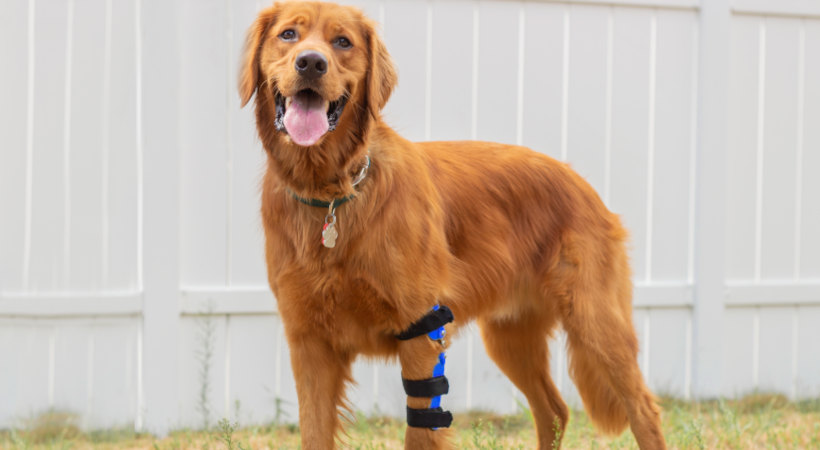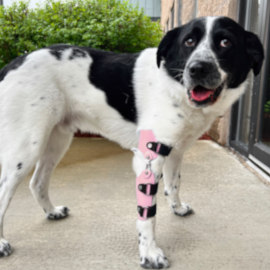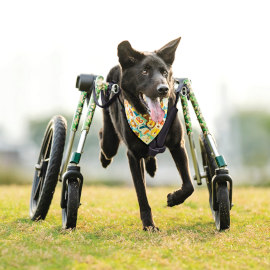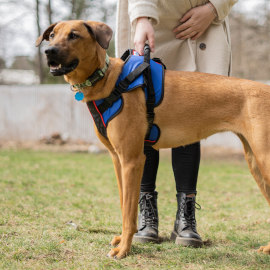A custom elbow orthotic supports the elbow joint, relieves joint pain, reduces inflammation, and stabilizes the upper front arm so that dogs can remain active as they heal. Custom bracing is recommended for chronic conditions, during injury recovery, or when surgery is not an option.
Where is my dog’s elbow?
A dog’s elbow is the second joint in the front limb, below the shoulder joint, and is found on the back of the front leg. A dog’s elbow is comprised of three bones, the humorous and the radius. When functioning correctly, a dog’s elbow allows for natural movement and range of motion in the front leg.
How can an elbow brace help my dog?
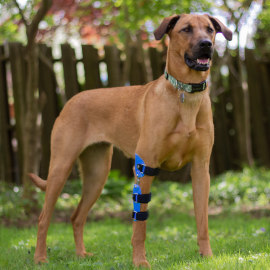
Canine ligament injuries occur when a tendon is overstretched or twisted. Although tendon tears are more common in a dog’s knee, they can also occur in the elbow. Supporting the elbow with a custom brace alleviates joint pain and protects the elbow from further injury as it heals. The elbow orthosis provides both medial and lateral stability to the upper arm.
In addition, the elbow brace prevents the dog from putting too much pressure on its injured elbow and keeps the forelimb in optimal alignment. Along with the injury, a front leg brace can also be for dogs dealing with joint pain from a degenerative joint condition or osteoarthritis.
Types of dog elbow problems:
- Elbow dysplasia
- Arthritis
- Elbow joint instability
- Elbow luxation
- Degenerative Joint Disease (DJD)
Dogs with arthritis or dysplasia should maintain a healthy weight. Obesity will further strain a dog’s front legs and worsen joint pain. In addition, dogs place most of their weight on their front limbs, meaning their elbows and shoulders take a lot of wear and tear, which is why choosing the right orthotic brace for your dog is crucial.
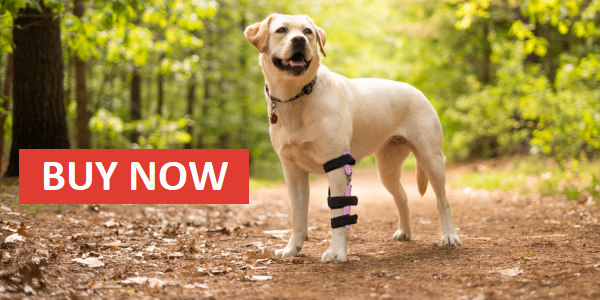
Can a dog elbow brace be worn on both legs?
Dogs can wear canine elbow braces on one or both front legs. When a dog wears two orthotics on both front limbs, it’s often referred to as bilateral elbow braces.
When should I consider using an elbow brace for my dog?

Your veterinarian may recommend an elbow brace if your dog shows signs of an elbow injury.
Elbow injury signs include:
- Limping or lifting the front leg off the ground while walking
- Joint stiffness, especially after a long walk or playtime
- Ebow appears swollen and sensitive to touch
- If dislocated, the dog may not be able to bear any weight on the injured leg
- Dog shows a reluctance to walk or exercise
By bracing the elbow joint, there is a reduced risk of elbow hyperextension, luxation, and the front leg is better stabilized allowing the dog to get back to daily activities.
Do I need a prescription for an elbow brace?
Although a prescription is unnecessary, always consult your veterinary physician before ordering an elbow orthosis. Each brace is custom fabricated to conform and support a dog’s elbow and customized to suit a dog’s specific diagnosis. Work with your veterinarian to determine the best plan for your dog’s recovery. Rehabilitation and veterinary follow-up are critical to a dog’s healing process. In most cases, additional treatments will be necessary. Your dog’s brace is just one piece of their treatment plan.
Helping your dog heal from an elbow joint injury
Custom elbow support is only one part of your dog’s rehabilitation. Contrary to popular belief, dogs don’t distribute their weight evenly across all four legs. Instead, the front legs, carpal, elbow, and shoulder joints support 60% of a dog’s total weight. Therefore, for severe elbow injuries and joint pain, it may also be necessary to find a safe way to support the front of your dog.
Front Support Harness
A front lift harness wraps around a dog’s chest and back. Most dog support harnesses feature a handle on the top that allows you to lift your dog safely. Support your dog’s front legs will make it easier for your dog to climb stairs and walk without placing full weight on their forelimbs.
Full Support Cart
Dogs unable to support themselves at all may require a full support wheelchair. This style dog wheelchair provides equal support to a dog’s front and back legs. Typically the front wheels of a quad wheelchair feature caster wheels. Casters allow for ease of movement and make it easier for a dog with weak front legs to maneuver and steer their cart.
Rehabilitation
Along with bracing, rehab therapies are beneficial for dogs with elbow dysplasia. Massage and hydrotherapy are just a few techniques that may be used for a pet with elbow issues. An underwater treadmill and swim therapy work to strengthen the front leg muscles with lower pain and less stress on the elbows. Strengthening the muscles around the elbow joint will help lessen the overall elbow pain. A supportive brace may be worn during treatments to limit joint pain as the dog moves.
